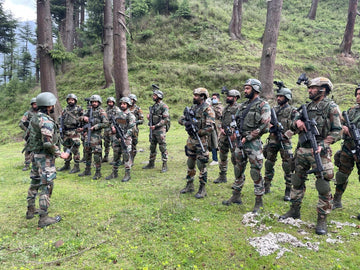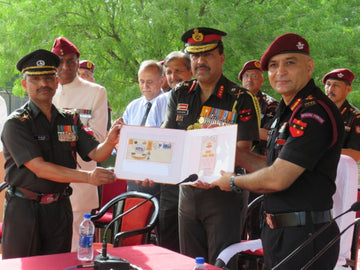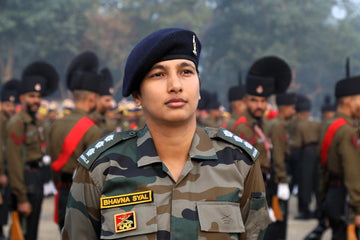The 9 Para Special Forces (9 Para SF), widely respected as one of the most lethal and effective units in the Indian Army, has a formidable legacy of valor, secrecy, and relentless operations. Known by nicknames such as “Pirates,” “Mountain Rats,” and “Ghost Operators,” this battalion of the Parachute Regiment is India's original Special Forces (SF) unit—revered for its surgical precision and deep-penetration capabilities in hostile territory.
Formation and Heritage
9 Para SF traces its origins back to the 1965 Indo-Pak War, when Colonel Megh Singh formed an ad hoc commando unit named the Meghdoot Force. This experiment proved successful and led to the official raising of the 9th Parachute Commando Battalion on 1 July 1966, making it the first special operations unit of the Indian Army’s Parachute Regiment.
The battalion’s early specialization in mountain warfare laid the foundation for its elite status as the mountain warfare specialists within the Special Forces community.

Nickname, Motto, and Identity
- Nicknames: Pirates, Mountain Rats, Ghost Operators
- Motto: “Minimum Men, Maximum Impact”
These labels speak volumes about the nature of the unit—stealthy, agile, and deadly, operating behind enemy lines with minimal resources but maximum effect.
Headquarters and Area of Operation
- Base: Udhampur, Jammu and Kashmir
- Primary Theatre: Kashmir Valley and Line of Control (LoC)
9 Para SF is permanently stationed in Jammu and Kashmir, where it undertakes Counter-Insurgency (COIN) and Counter-Terrorism (CT) operations almost daily. Their proximity to the LoC ensures they remain at the cutting edge of India’s war against cross-border terrorism.
Also Read: How to Become a Para SF Commando?
Training and Capabilities
Operatives of 9 Para SF undergo gruelling selection and specialized training before they earn the coveted “Balidan” badge. The training focuses on:
- Mountain Warfare (Primary specialty)
- Urban and Desert Warfare
- Combat Free Fall (HALO/HAHO) Parachuting
- Airborne and Heliborne Infiltration
- Guerrilla tactics, sabotage, deep penetration
- Close-quarter battle, hostage rescue, cyber warfare
- Foreign military exercises with global SF units like US Navy SEALs, UK SAS, and Russian Spetsnaz
It’s said that a 9 Para SF operative may participate in over 60 missions in two years, with many lasting for weeks in hostile zones.

Organizational Structure
- Team Size: Small squads of 5–6 highly trained operatives
- Modular Organization: Teams are trained for encryption, decryption, cyber operations, demolition, sniper support, and more.
- Command Style: Flat, flexible, and decentralized command system, allowing autonomy during real-time combat.
Major Operations and Achievements
Key Historical Operations:
| Operation | Year | Outcome |
|---|---|---|
| Chachro Raid & Mandhol Strike | 1971 | Deep raids in Pakistan; earned “Theatre Honour of J&K” |
| Operation Bluestar | 1984 | Removal of militants from the Golden Temple |
| Operation Pawan (Sri Lanka) | 1987 | LTTE insurgent suppression |
| Operation Cactus (Maldives) | 1988 | Rapid intervention during coup attempt |
| Kargil War | 1999 | High-altitude raids behind enemy lines |
Modern Era Operations:
- Operation Apache (2001): Retaliatory strike against Pakistani positions
- Pampore Stand-off (2016): Brave CQB engagement with terrorists inside EDI building
- Surgical Strikes (2016): Cross-LoC precision attacks post-Uri attack
- Myanmar Operation (2015): Eliminated insurgents post-Manipur ambush
- Operation Ginger: 2011 cross-border raid targeting Pakistani posts
They are also active year-round in thwarting terror infiltration and neutralizing threats in the Kashmir Valley.
Notable Heroes
The battalion has produced legendary soldiers who sacrificed everything in the line of duty:
- Captain Tushar Mahajan – Laid down his life during the 2016 Pampore encounter.
- Lance Naik Mohan Nath Goswami – Participated in multiple encounters, eliminated over 10 terrorists before martyrdom.
- Lance Naik Om Prakash – Decorated for bravery during CT operations.
Other Roles Beyond Combat
In addition to warfare, 9 Para SF also undertakes:
- Hostage Rescue and Anti-Hijacking Operations
- Strategic Reconnaissance and Intelligence Gathering
- Training Foreign Friendly Forces
- Disaster Relief Operations
Their versatility makes them invaluable in both war and peacetime scenarios.

Reputation and Legacy
9 Para SF has cultivated a reputation as India’s most secretive and efficient special operations unit. Often compared to Indian Navy MARCOs and foreign elite forces like the SAS and SEAL Team 6, they are known to strike silently and disappear before anyone even realizes.
The moniker “Ghost Operators” is not just symbolic—many of their operations are classified and never reach the public domain, but their impact is felt on the ground.
9 Para SF at a Glance
| Aspect | Details |
|---|---|
| Formation | July 1966 (Roots in Meghdoot Force, 1965) |
| Nicknames | Pirates, Mountain Rats, Ghost Operators |
| Motto | Minimum Men, Maximum Impact |
| Headquarters | Udhampur, Jammu & Kashmir |
| Primary Operations | COIN/CT in LoC & Kashmir Valley |
| Training | Mountain warfare, HALO/HAHO jumps, urban/desert combat |
| Notable Operations | 1971 War, Kargil, Bluestar, Myanmar, Surgical Strikes |
| Team Composition | 5–6 men per team, cyber and encryption experts included |
| Notable Personnel | Capt. Tushar Mahajan, LNk Mohan Goswami, LNk Om Prakash |
| Specialties | Deep penetration, sabotage, hostage rescue, intelligence ops |
Also Read: Can a Female Become Para SF Commando?
The 9 Para Special Forces stand as a beacon of courage, stealth, and elite professionalism. With a legacy carved through decades of fierce combat and daring missions, they remain India’s first line of offence when diplomacy ends and decisive action begins.
Their story is not just about warfare—it’s about unseen sacrifices, unmatched training, and a brotherhood that thrives on danger. They truly embody their motto:
“Minimum Men, Maximum Impact.”






